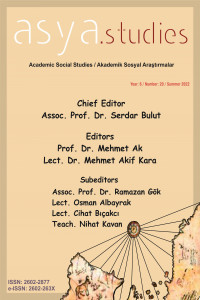EFFECTS OF BREATHING TECHNIQUES ON PROFESSIONAL SINGERS AND PATIENTS WITH RESPIRATORY DISEASES
Breath, Respiration, Lung, Singing, Respiratory Diseases
NEFES TEKNİKLERİNİN PROFESYONEL ŞARKICILAR VE SOLUNUM YOLU HASTALARI ÜZERİNDEKİ ETKİLERİ
Nefes, Solunum, Akciğer, Şan, Solunum Hastalıkları,
___
- American Lung Association. (2020). “How Serious Is COBD?”, Accessed on 31.05.2020 from https://www.lung.org/lung-health-diseases/lung-disease-lookup/copd
- Boston College Open Textbooks (2020). “Anatomy and Physiology, Organs and Structures of the Respiratory System”, BC Campus, Accessed on 31.05.2020 from https://opentextbc.ca/anatomyandphysiology/chapter/22-1-organs-and-structures-of-the-respiratory-system/
- Burri, P.H. (2006). Structural Aspects of Postnatal Lung Development-Alveolar Formation and Growth. Biology of the Neonate, 89, 313-322.
- Clift, S. and Gilbert, R. (2016). Can Singing Have A Beneficial Effect on Lung Function and Breathing for People with Respiratory Illness. (Ed. Welch, G., Howard, D., and Nix, J.). in The Oxford Handbook of Singing. Oxford: Oxford University Press.
- Çakan, M. ve Gülnihal, G. Ü. L. (2018). Ses Eğitiminde Kullanılan Nefes ve Ses Egzersizlerinin Konuşma Bozukluklarının Giderilmesinde Kullanılabilirliği. Afyon Kocatepe Üniversitesi Akademik Müzik Araştırmaları Dergisi, 4 (8): 50-63.
- Davidova, J.; Zavadska, G.; Rauduvaitė, A. and Chuang, M. J. (2017). Strategies for the Development of 6-8-Year-Old Children’s Breathing for Singing. Pedagogika, 125 (3): 111-121.
- Desjardins, M. and Bonilha, H. S. (2019). The Impact of Respiratory Exercises on Voice Outcomes: A Systematic Review of the Literature. Journal of Voice, 34 (4): 648.e1-648.e39.
- Encyclopedia Britannica (2006). “Diaphragm; Breathing”, Accessed on 31.05.2020 from https://www.britannica.com/science/human-respiratory-system/The-respiratory-pump-and-its-performance#/media/1/499530/99770
- Encyclopedia Britannica (2020). “Human Respiratory System, The Mechanics of Breathing”, Accessed on 31.05.2020 from https://www.britannica.com/science/human-respiratory-system/The-mechanics-of-breathing
- EPA. (2015). “Particulate Matter”, U.S. Environmental Protection Agency, Accessed on 31.05.2020 from https://www.epa.gov/pm-pollution
- ER Services. (2020). “The Process of Breathing, Anatomy and Physiology II”, Accessed on 31.05.2020 from https://courses.lumenlearning.com/suny-ap2/chapter/the-process-of-breathing-no-content/
- Evren, G. F. (2006). Ses Eğitimi Yöntemlerinin Ses Hastalıklarının Tedavisinde Kullanımı, (Ph.D. Dissertation), Konya: Selçuk Üniversitesi Sosyal Bilimler Enstitüsü.
- GOLD. (2015). “Global Strategy for the Diagnosis, Management, and Prevention of Chronic Obstructive Pulmonary Disease”, Global Initiative for Chronic Obstructive Lung Disease, Accessed on 31.05.2020 from https://goldcopd.org/Guidelines/guidelines-resources.html
- Goldenberg, R. B. (2018). Singing Lessons for Respiratory Health: A Literature Review. Journal of Voice, 32 (1): 85-94.
- Gordon, K. E. and Reed, O. (2020). The Role of the Pelvic Floor in Respiration: A Multidisciplinary Literature Review. Journal of Voice, 34 (2): 243-249.
- Han, P. (2018). Principles of Appoggio: The Interrelationship Between Theory and Practice for Today's Young Opera Singers, (Ph.D. Dissertation), Bloomington: Indiana University.
- Harding, R. and Maritz, G. (2012). Maternal and Fetal Origins of Lung Disease in Adulthood. Seminars in Fetal & Neonatal Medicine, 17, 67-72.
- Herbst, C. T. (2017). A Review of Singing Voice Subsystem Interactions-Toward an Extended Physiological Model of ‘Support’. Journal of Voice, 31 (2): 249.e13-249.e19.
- Lopez E.; Lee, S. H.; Bahr, R.; Carey, S. L.; Mott, B.; Fults, A.; Lazinski, M. and Kim, E. S. (2020). Breathing Techniques in Collegiate Vocalists: The Effects of the Mind-Body Integrated Exercise Program on Singers’ Posture, Tension, Efficacy, and Respiratory Function. (Ed. Lee S. H., Morris M., and Nicosia S.). in Perspectives in Performing Arts Medicine Practice (p. 111-125). Cham: Springer International Publishing.
- Kim, S. (2019). "Support vs. Steady Airflow: The Effect of Two Different Instructions on Subglottal Pressure, Sound Pressure Level, and Airflow Rate during Singing and Speaking", CUNY Academic Works, Accessed on 30.05.2020 from https://academicworks.cuny.edu/gc_etds/3499
- McCombes, S. (2019). “How to Write a Literature Review”, Accessed in 29.06.2020 from https://www.scribbr.com/dissertation/literature-review/
- Paroni, A.; Calabrese, P.; Savariaux, C.; Baraduc, P. and Loevenbruck, H. (2019). Ventilatory Dynamics in Human Beatboxing: Is It Similar to Speech and Singing, 13th Pan-European Voice Conference, August 2019, Copenhagen.
- Petersen, J. (2014). “W. Stephen Smith on Breathing”, Petersen Voice Studio, Accessed on 30.05.2020 from https://petersenvoicestudio.com/2014/11/06/w-stephen-smith-on-breathing/
- Smith, W. S. (2007). The Naked Voice: A Wholistic Approach to Singing. Oxford: Oxford University Press.
- Soriano, J.B.; Zielinski, J. and Price, D. (2009). Screening for and Early Detection of Chronic Obstructive Pulmonary Disease. The Lancet, 374, 721-732.
- Stegemöller, E. L.; Radig, H.; Hibbing, P.; Wingate, J. and Sapienza, C. (2017). Effects of Singing on Voice, Respiratory Control and Quality of Life in Persons with Parkinson’s Disease. Disability and Rehabilitation, 39 (6): 594-600.
- Stocks, J.; Hislop, A. and Sonnappa, S. (2013). Early Lung Development: Lifelong Effect on Respiratory Health and Disease. The Lancet, 1 (9): 728-742.
- Thorpe, C.W.; Cala, S. J.; Chapman, J. and Davis, P. J. (2001). Patterns of Breath Support in Projection of the Singing Voice. Journal of Voice, 15 (1): 86-104.
- Traser, L.; Özen, A. Ç.; Burk, F.; Burdumy, M.; Bock, M.; Richter, B. and Echternach, M. (2017). Respiratory Dynamics in Phonation and Breathing-A Real-Time MRI Study. Respiratory Physiology & Neurobiology, 236, 69-77.
- Uğurtay, Ö. (2006). Ses Kısıklığı Yakınması Olan Hastalarda Tedavinin Etkinliğinin Değerlendirilmesi, (Ph.D. Dissertation), İzmir: Dokuz Eylül Üniversitesi Sağlık Bilimleri Enstitüsü.
- University of Hawaii at Manoa (2009). “Research: Biophysical Study of Lung Surfactant, Laboratory of Biocolloids and Biointerfaces”, University of Hawaii Mechanical Engineering Department, Accessed on 31.05.2020 from http://www2.hawaii.edu/~yzuo/research1-surfactant.html
- Wade, L. M. (2017). A Pilot Study of Pursed-Lip Breathing, Singing, and Kazoo Playing on Lung Function and Perceived Exertion of Participants Who Smoke, (Ph.D. Dissertation), Kansas: University of Kansas Music Education & Music Therapy Department.
- White Jr, R. C. (1988). On the Teaching of Breathing for the Singing Voice. Journal of Voice, 2 (1): 26-29.
- Yıldırım, K. (2010). Raising the Quality in Qualitative Research. İlköğretim Online, 9 (1): 79-92.
- ISSN: 2602-2877
- Yayın Aralığı: Yılda 4 Sayı
- Başlangıç: 2017
- Yayıncı: Mehmet Akif KARA
PSİKANALİTİK BİR ÇÖZÜMLEME ÖRNEĞİ: ANAR RIZABAYEV’İN AK LİMAN ROMANI
KARAKTER EĞİTİMİ AÇISINDAN VLADİMİR TUMANOV’UN ROMANLARINDAKİ ÇOCUK KARAKTERLERİN DEĞERLENDİRİLMESİ
EFFECTS OF BREATHING TECHNIQUES ON PROFESSIONAL SINGERS AND PATIENTS WITH RESPIRATORY DISEASES
HİNDİSTAN YAHUDİLERİ: BENİ İSRAİL KABİLESİ VE HİNDİSTAN - İSRAİL İLİŞKİLERİNE ETKİLERİ
“TÜKETİM TOPLUMU” KAVRAMININ POZİTİVİST, ELEŞTİREL, YORUMSAMACI YAKLAŞIMLARLA İRDELENMESİ
AYŞE KULİN’İN GECE SESLERİ ADLI ROMANINDA KADINA YÖNELİK ŞİDDET
TÜRK SİYASİ HAYATININ GELİŞİMİ BAĞLAMINDA İTTİHAT VE TERAKKİ PARTİSİ İLE BAB-I ALİ BASKINI (1913)
POST-TRUTH DÖNEMDE SOSYAL MEDYADA DEZENFORMASYON: COVİD-19 (YENİ KORONAVİRÜS) PANDEMİ SÜRECİ
İKİ DİLLİ KÜÇÜK KAMUS-I FRANSEVÎ’NİN SÖZLÜK BİLİMİ AÇISINDAN İNCELENMESİ
